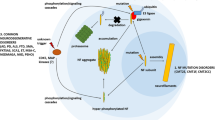Abstract
Neuroaxonal dystrophy is a feature of neuronal degeneration encountered in all subacute spongiform virus encephalopathies including scrapie and Creutzfeldt-Jakob disease (CJD). By immunohistochemical techniques, the accumulation of 200 kDa neurofilament protein was demonstrated in affected neurites in human CJD. These neurites exhibited the ultrastructural features of dystrophic neurites encountered in other neurodegenerative disorders, particularly Alzheimer's disease. These findings support the hypothesis that impairment of slow axoplasmic transport is a common pathogenetic mechanism for CJD and many other neurodegenerative conditions.
Similar content being viewed by others
References
Clark A. W., Parhard I. M., Griffin J. W., and Price D. L. (1984) Neurofilamentous axonal swellings as a normal finding in the spinal anterior horn of man and other primates.J. Neuropathol. Exp. Neurol. 43, 253–262.
Gajdusek D. C. (1984) Interference with axonal transport of neurofilaments as the common etiology and pathogenesis of neurofibrillary tangles, amyotrophic lateral sclerosis, parkinsonism-dementia, and many other degenerations of the cns: a series of hypothesis, inAmyotrophic Lateral Sclerosis in Asia and Oceania.Proceedings of the Sixth Asian and Oceanian Congress of Neurology. Amyotrophic Lateral Sclerosis Workshop, Taipei, Taiwan, Republic of China, Nov. 14, 1983 (Chen K. M., Yase Y., eds.), Shyan-Fu Chou, National Taiwan University, pp. 423–436.
Gajdusek D. C. (1985a) Hypothesis: interference with axonal transport of neurofilaments as a common pathogenetic mechanism in certain diseases of the central nervous system.N. Engl. J. Med. 209, 714–719.
Gajdusek D. C. (1985b) Interference with axonal transport of neurofilaments as a mechanism of pathogenesis underlying Alzheimer's disease and many other degenerations of the CNS, inNormal Aging, Alzheimer's Disease and Senile Dementia. Aspects of Etiology, Pathogenesis, Diagnosis and Treatment (Gottfries C. G., ed.), Edititions de l'Universite Bruxelles, Bruxelles, pp. 51–67.
Gajdusek D. C. (1987) A newly recognized mechanism of pathogenesis in Alzheimer's disease, amyotrophic lateral sclerosis, and other degenerative neurological diseases: the beta-fibrilloses of brain, inNutrition, Health and Peace. Proc. Int. Symp. Honor of Linus Pauling (Jariwalla R. J. and Schwoebel S. L., eds.), Linus Pauling Inst., Palo Alto, pp. 21–55.
Jeffrey M., Fraser H., Halliday W. G., Fowler N., Goodsir C. M., and Brown D. A. (1995) Early unsuspected neuron and axon terminals loss in scrapie-infected mice revealed by morphometry and immunocytochemistry.Neuropathol. Appl. Neurobiol. 21, 41–49.
Liberski P. P. and Budka H. (1992) An overview of neuropathology of the slow unconventional virus infectios, inLight and Electron Microscopic Neuropathology of Slow Virus Infections, (Liberski P. P., ed.), CRC, Boca Raton, FL, pp. 111–153.
Liberski P. P., Budka H., Yanagihara R., and Gajdusek D. C. (1995) Neuroaxonal dystrophy in experimental Creutzfeldt-Jakob disease: electron microscopical and immunohistochemical demonstration of neurofilament accumulations within affected neurites.J. Comp. Pathol. 112, 243–255.
Schlapfer W. W. (1987) Neurofilaments: structure, metabolism and implications in disease.J. Neuropathol. Exp. Neurol. 46, 117–129.
Smith M. C. (1955) Argyrophilic bodies in the human spinal cord.J. Neurol. Neurosurg. Psychiatr. 18, 13–16.
Author information
Authors and Affiliations
Rights and permissions
About this article
Cite this article
Liberski, P.P. How do neurons degenerate in transmissible spongiform encephalopathies?. Molecular and Chemical Neuropathology 28, 245–249 (1996). https://doi.org/10.1007/BF02815229
Received:
Accepted:
Published:
Issue Date:
DOI: https://doi.org/10.1007/BF02815229



